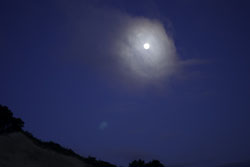JO, KG and I led 11 participants on a night hike at Long Ridge on Friday, 8/17/12. The evening was surprisingly warm after the two scouting trips that we had done on the previous Friday and the night before, on which we did the route in reverse like we used to do. We started walking at 6:30. As on our scouting trips, the frit flies were annoying, and a few mosquitoes were out.
Some people saw a deer. We stopped at the first intersection to look at the relatively large eggshell we’d found on the previous night. We continued on and started up the hill. Our second stop was where we had stashed a Barn Owl leading-edge wing feather, which we’d found on our first scouting trip. We talked about flight feathers and compared the owl feather’s silence compared to a turkey feather by slicing them through the air (thanks to KP for that idea).
Our next stop was at a mossy trailbank where we had found trapdoor spider burrows (family Cyrtaucheniidae). These spiders make a thin (wafer) lid of silk and camouflage it to match the substrate. On the previous night when we got there after dark, upon opening one of the lids gently, a spider sat waiting for prey to come by. Another trapdoor appeared either sealed or held closed tightly by the occupant. On the previous night, it was not sealed but the spider was not behind the lid. We found a couple of tiny trapdoors also, with only fine dirt for camouflage.
We arrived at the big open intersection with Long Ridge Trail (halfway to the bench) at 7:10. On the previous Friday, we had examined a tubular, closed spider burrow at the base of a tree, and on our second scouting trip after dark we saw no occupant. But what we hadn’t noticed a week prior, maybe because they had emerged in the meantime, were at least 7 cicada exuviae low on the tree. Cicada nymphs feed on sap from roots, and when ready to become adults, dig up and climb something upon which to molt.
One more planned stop on the way to the ridge was a pile of woodpecker feathers we’d found on the previous Friday. The black and white feathers with stiff ends clued us in to the type of bird; woodpeckers use their tails to prop themselves against trees. There was a pile of body feathers, and a few wing and tail feathers. From the size we knew it was a smaller woodpecker (and not a Pileated Woodpecker, remains of which we have also found at Long Ridge). During the week, I used The Feather Atlas to identify the feathers: Acorn Woodpecker. We discussed the possibilities of what kind of predator left the remains.
Sunset was at ~8:00, and we arrived at the bench at 7:45. The sky had high clouds, some of which looked as though they were shedding light rain in the distance. We started walking again at 8:25. I felt a couple of drops along the ridge. It was unfortunate that we didn’t have clear skies, as we’d had a view of Saturn, Mars, and Spica in a triangle the previous night. It was dark enough to find several scorpions (the goal of the young boy who came on the hike) with no moon, and we stopped to look at them. A couple of bats fluttered by. We’d seen some snake tracks in the dust last week, but not this time; we did see turkey and deer tracks. Some of the people saw two big wolf spiders.
On our first scouting hike, at one harvester ant nest on the ridge, we found one Parcoblatta cockroach like those we’ve recently seen many of at Monte Bello, also at harvester ant nests. We stopped briefly at 9:00 before making our next turn. Shortly, we found our first spider turret, and we continued to search holes in that stretch of trail for about 20 minutes. The boy had borrowed one of our UV lights to search for scorpions, and he found the one Uroctonus mordax in full view for the trip. Various black beetles, including Scaphinotus (snail eaters) and many small crickets occupied the trails. We found no tiger beetle larvae, or for that matter, no large spiders. There were a few large spider holes in the trails, but no visible legs in the ones we refound. There were numerous spiders (probably Cybaeus) with a chevron pattern on their abdomens, which we’ve seen here before.
With permission, the pond was our next stop, and we reached it at 9:35. Bats flew in the beams of our flashlights. A green katydid was stuck in the duckweed that covered the surface, and JO retrieved it.
We had enough time to do a spaced-out silent walk, and the last person started off at 10:05. From the “newt pond” (which had dried up since last week when it had a little water), it took ten minutes to reach the turn back to the trailhead, and after checking a spider hole for an occupant unsuccessfully, we arrived back at 10:25.
On our way down Page Mill near Monte Bello, a Barn Owl flew low out of Los Trancos, over the car, and down the road in front of us for about five wing flaps. That was a cool ending to a warm night!
Photos are here.




